一般现在时和现在进行时的用法 动词单三形式
- 格式:doc
- 大小:39.00 KB
- 文档页数:4
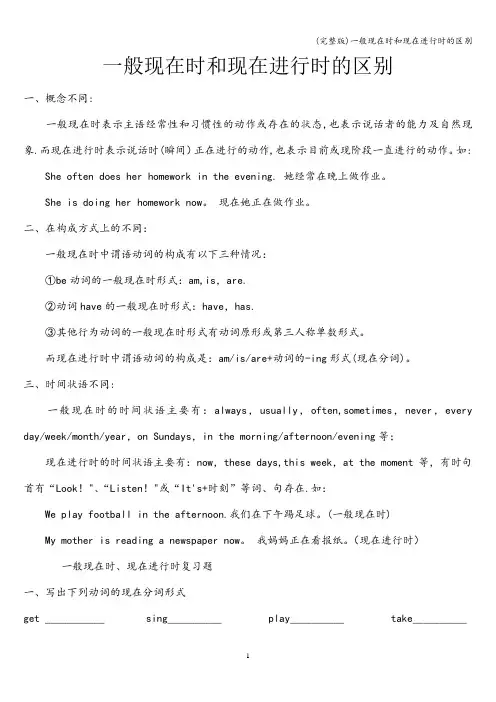
一般现在时和现在进行时的区别一、概念不同:一般现在时表示主语经常性和习惯性的动作或存在的状态,也表示说话者的能力及自然现象.而现在进行时表示说话时(瞬间)正在进行的动作,也表示目前或现阶段一直进行的动作。
如: She often does her homework in the evening. 她经常在晚上做作业。
She is doing her homework now。
现在她正在做作业。
二、在构成方式上的不同:一般现在时中谓语动词的构成有以下三种情况:①be动词的一般现在时形式:am,is,are.②动词have的一般现在时形式:have,has.③其他行为动词的一般现在时形式有动词原形或第三人称单数形式。
而现在进行时中谓语动词的构成是:am/is/are+动词的-ing形式(现在分词)。
三、时间状语不同:一般现在时的时间状语主要有:always,usually,often,sometimes,never,every day/week/month/year,on Sundays,in the morning/afternoon/evening等;现在进行时的时间状语主要有:now,these days,this week,at the moment等,有时句首有“Look!"、“Listen!"或“It's+时刻”等词、句存在.如:We play football in the afternoon.我们在下午踢足球。
(一般现在时)My mother is reading a newspaper now。
我妈妈正在看报纸。
(现在进行时)一般现在时、现在进行时复习题一、写出下列动词的现在分词形式get ___________ sing__________ play__________ take__________study_________ dance_________ have__________ write__________ run___________ sit___________ shop__________ swim__________二、写出下列动词的第三人称单数形式work__________ read__________ clean__________ write__________teach__________ wash__________ guess__________ watch__________go____________ do___________ photo__________ study__________fly__________ cry__________ play_________ have__________三、用动词的适当形式填空1. She ______________ (go) to school at eight o'clock。
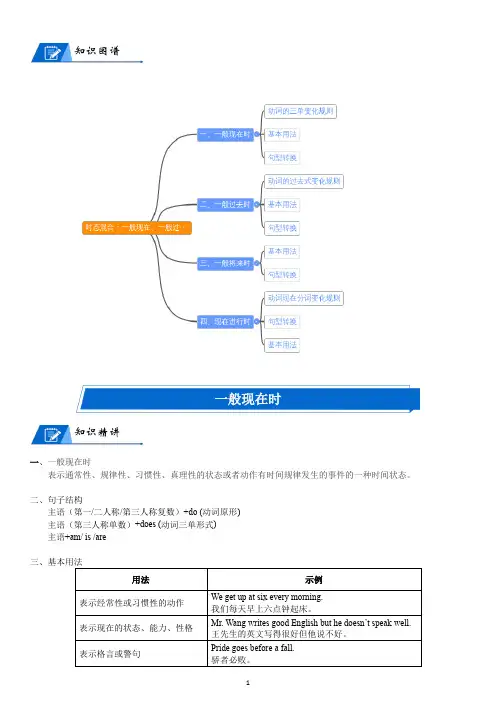
知识图谱一般现在时知识精讲一、一般现在时表示通常性、规律性、习惯性、真理性的状态或者动作有时间规律发生的事件的一种时间状态。
二、句子结构主语(第一/二人称/第三人称复数)+do (动词原形)主语(第三人称单数)+does (动词三单形式)主语+am/ is /are用法示例表示经常性或习惯性的动作We get up at six every morning.我们每天早上六点钟起床。
表示现在的状态、能力、性格Mr. Wang writes good English but he doesn’t speak well.王先生的英文写得很好但他说不好。
表示格言或警句Pride goes before a fall.骄者必败。
表示永恒的客观真理The earth moves around the sun.地球绕着太阳转。
四、时间状语1. 表示频率的副词: always, usually, often, sometimes, never, hardly, seldom…2. every/once+名词: every day/ week/ year, once a week/ month …3. 表示时间的短语: twice a day, on weekends, on Mondays…情况变形示例一般情况加-s help-helps play-plays以辅音字母+o结尾加-es go-goes do-does以x, sh, ch, s结尾加-es teach-teaches brush-brushes以辅音字母+y结尾变y为i加es study-studies try-tries特殊情况没有统一的规则have-has; be-isbe动词行为动词用法我是am你是are;is跟着他/她/它;复数都用are。
主语是第三人称单数外,都用动词原形;主语是第三人称单数时,动词词尾加-s或-es。
肯定式I am a student.我是一名学生。
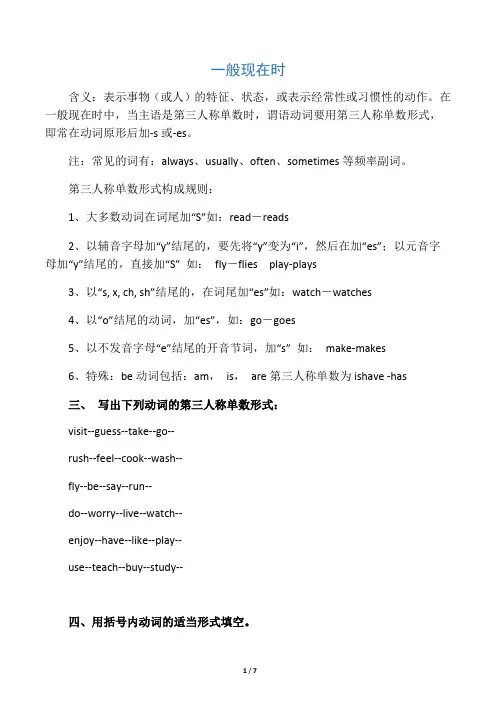
一般现在时含义:表示事物(或人)的特征、状态,或表示经常性或习惯性的动作。
在一般现在时中,当主语是第三人称单数时,谓语动词要用第三人称单数形式,即常在动词原形后加-s或-es。
注:常见的词有:always、usually、often、sometimes等频率副词。
第三人称单数形式构成规则:1、大多数动词在词尾加“S”如:read-reads2、以辅音字母加“y”结尾的,要先将“y”变为“i”,然后在加“es”;以元音字母加“y”结尾的,直接加“S” 如:fly-flies play-plays3、以“s, x, ch, sh”结尾的,在词尾加“es”如:watch-watches4、以“o”结尾的动词,加“es”,如:go-goes5、以不发音字母“e”结尾的开音节词,加“s” 如:make-makes6、特殊:be动词包括:am,is,are第三人称单数为ishave -has三、写出下列动词的第三人称单数形式:visit--guess--take--go--rush--feel--cook--wash--fly--be--say--run--do--worry--live--watch--enjoy--have--like--play--use--teach--buy--study--四、用括号内动词的适当形式填空。
1. She often __________ (have)lunch at home.2. Sarah and Tom __________ (be) in Class One.3. We__________ (not watch) TV on Monday.4. Oliver __________ (not go) to school on Sunday.5.__________ they __________ (like)playing football?6. What __________ they often__________ (do) on Saturdays?7. __________ your parents __________ (read) newspapers?8. The girl__________ (teach) us English on Sundays.9. She and I __________ (take) a walk together every evening.10. There __________ (be) some water in the bottle.11. Mike__________ (like) cooking.12. He__________ (have) two new books.13. My sister __________ (look) after her baby carefully.14. You always __________ (do) your homework well.15. I__________ (be) ill. I’m staying in bed.16. She __________ (go) to school from Monday to Friday.17. Liu Tao __________ (do) not like PE.18. The child often __________ (watch) TV in the evening.19. -What day __________(be) it today?-It’s Saturday-How__________Dad __________(feel)?-He __________(feel) not well.-Where__________ he __________(work)?-He __________(work) at sea.现在进行时含义:表示正在做某事。
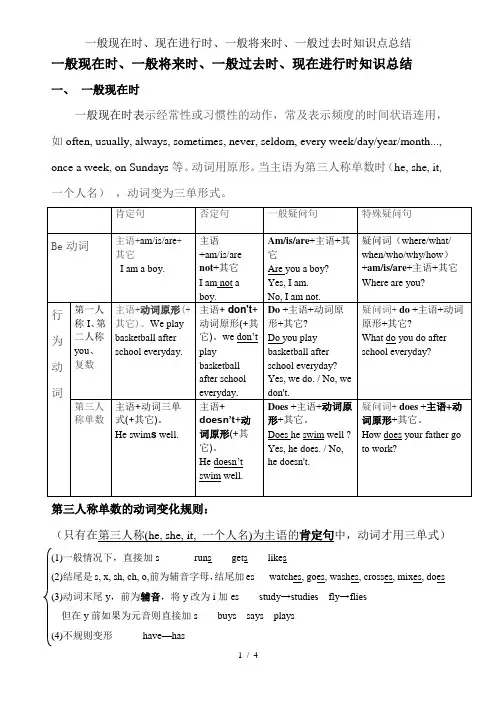
一般现在时、一般将来时、一般过去时、现在进行时知识总结一、一般现在时一般现在时表示经常性或习惯性的动作,常及表示频度的时间状语连用,如often, usually, always, sometimes, never, seldom, every week/day/year/month..., once a week, on Sundays等。
动词用原形。
当主语为第三人称单数时(he, she, it, 一个人名),动词变为三单形式。
第三人称单数的动词变化规则:(只有在第三人称(he, she, it, 一个人名)为主语的肯定句中,动词才用三单式)(1)一般情况下,直接加s runs gets likes(2)结尾是s, x, sh, ch, o,前为辅音字母,结尾加es watches, goes, washes, crosses, mixes, does(3)动词末尾y,前为辅音,将y改为i加es study→studies fly→flies但在y前如果为元音则直接加s buys says plays(4)不规则变形have—has二、一般将来时一般将来时表示将来发生的事。
常及tomorrow, next day/week/month/year..., soon, in a few minutes, the day after tomorrow, in the future等时间状语连用。
Will/shall +动词原形;(shall用语第一人称)be(am/is/are) going to+ 动词原形三、一般过去时一般过去时表示过去某一时候或某一段时间所发生了的事情或存在的状态。
常及过去时间yesterday,ago, this morning,just now,a moment ago,last night / year / week/month,once upon a time,the other day,before,the day before yesterday, in 1989, at the age of five, one day, then(那时), on that day,in the past连用。

现在进行时的构成及用法【No. 1】现在进行时的定义及构成:现在进行时表示正在进行或发生的动作现在进行时构成:主语+be+动词ing〔现在分词〕形式第一人称单数+am+动词-ing第三人称单数+is+动词-ing其他人称(第一人称复数,第二人称单、复数,第三人称复数) +are+动词-ing【No. 2】现在进行时的应用在实际运用时,现在进行时常用以下几种情况:(1)当句子中有now时,常表示动作正在进行,这时要用现在进行时。
如:They are playing basketball now .现在他们正在打篮球。
⑵以look!, listen!开头的句子,提示我们动作正进行,这时要用现在进行时。
如:Listen ! She is singing an English song.听,她正在唱英语歌。
⑶表示当前一段时间或现阶段正在进行的动作,且此时有this week, these days等时间状语,这时常用现在进行时。
如:We are making model planes these days .这些天我们在做飞机模型。
(4)描述图片中的人物的动作,也为了表达更生动。
此时也常用现在进行时。
如:Look at the picture. The children are flying kites in the park. 看这幅图,那些孩子正在公园放风筝。
【No. 3】现在进行时的变化肯定句式:主语+be( am, is, are)+现在分词+其它.否定句式:主语+be(am, is, are) +not + 现在分词+其它.一般疑问句:Be(am, is, are) +主语+现在分词+其它?特殊疑问句:疑问词+be(am, is, are)+主语+现在分词+其它?对现在进行时的特殊疑问句的回答,它不可以用Yes或No直接作答,要根据实际情况回答。
一般现在时的构成及用法【No. 1】一般现在时的定义及构成:一般现在时表示现在经常反复发生的动作、存在的状态或习惯性的动作。
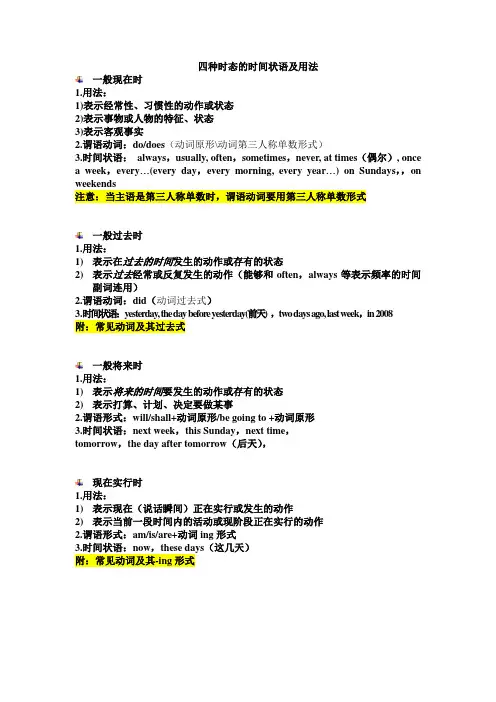
四种时态的时间状语及用法一般现在时1.用法:1)表示经常性、习惯性的动作或状态2)表示事物或人物的特征、状态3)表示客观事实2.谓语动词:do/does(动词原形\动词第三人称单数形式)3.时间状语:always,usually, often,sometimes,never, at times(偶尔), oncea week,every…(every day,every morning, every year…) on Sundays,,on weekends注意:当主语是第三人称单数时,谓语动词要用第三人称单数形式一般过去时1.用法:1)表示在过去的时间发生的动作或存有的状态2)表示过去经常或反复发生的动作(能够和often,always等表示频率的时间副词连用)2.谓语动词:did(动词过去式)3.时间状语:yesterday, the day before yesterday(前天) ,two days ago, last week,in 2008附:常见动词及其过去式一般将来时1.用法:1)表示将来的时间要发生的动作或存有的状态2)表示打算、计划、决定要做某事2.谓语形式:will/shall+动词原形/be going to +动词原形3.时间状语:next week,this Sunday,next time,tomorrow,the day after tomorrow(后天),现在实行时1.用法:1)表示现在(说话瞬间)正在实行或发生的动作2)表示当前一段时间内的活动或现阶段正在实行的动作2.谓语形式:am/is/are+动词ing形式3.时间状语:now,these days(这几天)附:常见动词及其-ing形式。
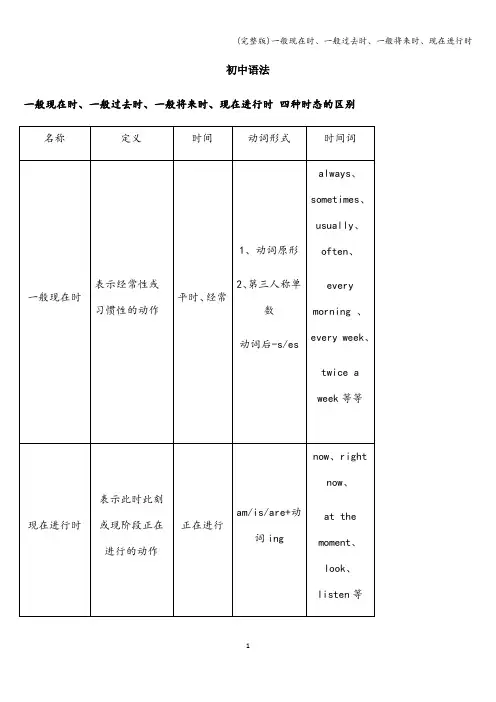
初中语法一般现在时、一般过去时、一般将来时、现在进行时四种时态的区别注意:1、一般现在时——第三人称单数的动词变化规则:1)大多数动词在词尾加“S"如:stop-______ ; make-______ read-______ ; play-______2)以辅音字母加“y”结尾的,要先将“y”变为“i",然后在加“es”如:fly-______ ; carry-______ study-______ ; worry-______3)以“s, x, ch, sh”结尾的,在词尾加“es"如:teach-______ ; watch-______4)以“o”结尾的动词,加“es”如:go-______ do-______2、现在进行时——动词ing形式的变化规则1.一般动词直接在词尾+ing例:read→______ (读) talk→______(交谈) sing→______(唱歌)2。
以不发音e结尾的动词,先去e再加ing例:like→______喜欢 write→______写 skate→______(滑冰)3。
以重读闭音节结尾且末尾只有一个辅音字母的动词,双写末尾字母,再加ing 例:stop→______(停止) get→______(得到)4.少数几个以ie结尾的动词,变ie为f再加ing.例:lie→______(躺、撒谎) tie→______(系、捆绑)3、一般过去时——动词的变化规则(1)一般在动词后加-ed。
如:play-______, offer-______, weigh—______, destroy—______, sign—______(2)在以字母e结尾的动词后,只加-d。
如:like—______, provide-______, hate - ______ date-______(3) 在以“辅音字母+y”结尾的动词后,则改y为i,再加—ed。
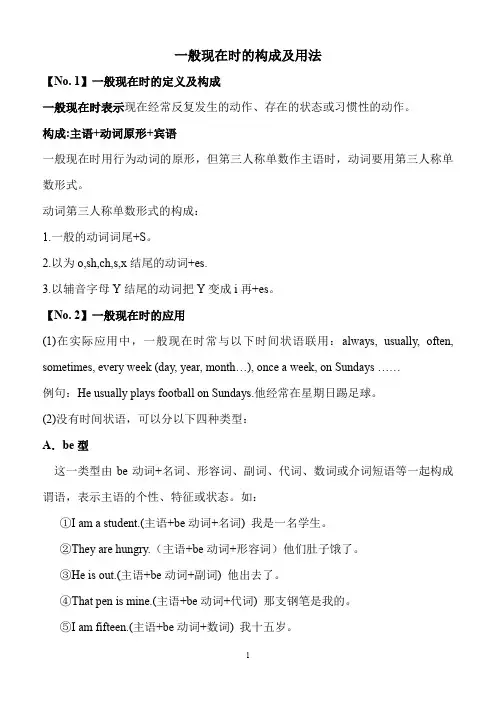
一般现在时的构成及用法【No. 1】一般现在时的定义及构成一般现在时表示现在经常反复发生的动作、存在的状态或习惯性的动作。
构成:主语+动词原形+宾语一般现在时用行为动词的原形,但第三人称单数作主语时,动词要用第三人称单数形式。
动词第三人称单数形式的构成:1.一般的动词词尾+S。
2.以为o,sh,ch,s,x结尾的动词+es.3.以辅音字母Y结尾的动词把Y变成i再+es。
【No. 2】一般现在时的应用(1)在实际应用中,一般现在时常与以下时间状语联用:always, usually, often, s ometimes, every week (day, year, month…), once a week, on Sundays ……例句:He usually plays football on Sundays.他经常在星期日踢足球。
(2)没有时间状语,可以分以下四种类型:A.be型这一类型由be动词+名词、形容词、副词、代词、数词或介词短语等一起构成谓语,表示主语的个性、特征或状态。
如:①I am a student.(主语+be动词+名词) 我是一名学生。
②They are hungry.(主语+be动词+形容词)他们肚子饿了。
③He is out.(主语+be动词+副词) 他出去了。
④That pen is mine.(主语+be动词+代词) 那支钢笔是我的。
⑤I am fifteen.(主语+be动词+数词) 我十五岁。
⑥The bike is under the tree.(主语+be动词+介词短语) 那辆自行车在树下。
B.do型do型由行为动词充当谓语,表示经常性或习惯性的动作,其构成为“主语+动词原形或动词第三人称单数形式”。
如:①I know it. 我知道这。
②He believes me. 他相信我。
C.there be型there be型句子表示“存在”,其构成为“there be+主语+其他”,表示客观事实。
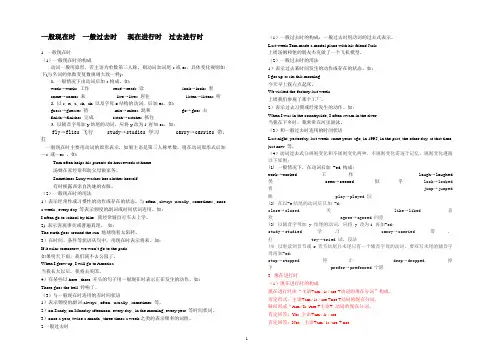
一般现在时一般过去时现在进行时过去进行时1. 一般现在时(1)一般现在时的构成动词一般用原形,若主语为单数第三人称,则动词加词尾-s或-es,具体变化规则如下(与名词的单数变复数规则大致一样):1.一般情况下由动词后加-s构成。
如:work→works 工作read→reads 读look→looks 看come→comes 来live→lives 居住listen→listens 听2.以s, x, z, sh, ch 以及字母o结构的动词,后加-es。
如:guess→guesses 猜mix→mixes 混和go→goes 去finish→finishes 完成catch→catches 抓住3.以辅音字母加y结尾的动词,应将y改为i 再加-es。
如:fly→flies 飞行study→studies 学习carry→carries 带,扛一般现在时主要用动词的原形表示,如果主语是第三人称单数,则在动词原形式后加—s 或—es 。
如:Tom often helps his parents do housework at home.汤姆在家经常邦助父母做家务。
Sometimes Lucy washes her clothes herself.有时候露西亲自洗她的衣服。
(2)一般现在时的用法1)表示经常性或习惯性的动作或存在的状态。
与often , always ,usually , sometimes , once a week , every day 等表示频度的副词或时间状词连用。
如:I often go to school by bike. 我经常骑自行车去上学。
2) 表示客观事实或普遍真理。
如:The earth goes around the sun .地球绕着太阳转。
3)在时间、条件等状语从句中,用现在时表示将来。
如:If it rains tomorrow, we won’t go to the park.如果明天下雨,我们就不去公园了。
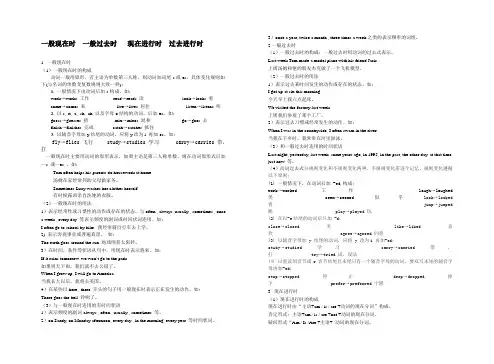
一般现在时一般过去时现在进行时过去进行时1. 一般现在时(1)一般现在时的构成动词一般用原形,若主语为单数第三人称,则动词加词尾-s或-es,具体变化规则如下(与名词的单数变复数规则大致一样):1.一般情况下由动词后加-s构成。
如:work→works 工作read→reads 读look→looks 看come→comes 来live→lives 居住listen→listens 听2.以s, x, z, sh, ch 以及字母o结构的动词,后加-es。
如:guess→guesses 猜mix→mixes 混和go→goes 去finish→finishes 完成catch→catches 抓住3.以辅音字母加y结尾的动词,应将y改为i 再加-es。
如:fly→flies 飞行study→studies 学习carry→carries 带,扛一般现在时主要用动词的原形表示,如果主语是第三人称单数,则在动词原形式后加—s 或—es 。
如:Tom often helps his parents do housework at home.汤姆在家经常邦助父母做家务。
Sometimes Lucy washes her clothes herself.有时候露西亲自洗她的衣服。
(2)一般现在时的用法1)表示经常性或习惯性的动作或存在的状态。
与often , always ,usually , sometimes , once a week , every day 等表示频度的副词或时间状词连用。
如:I often go to school by bike. 我经常骑自行车去上学。
2) 表示客观事实或普遍真理。
如:The earth goes around the sun .地球绕着太阳转。
3)在时间、条件等状语从句中,用现在时表示将来。
如:If it rains tomorrow, we won’t go to the park.如果明天下雨,我们就不去公园了。
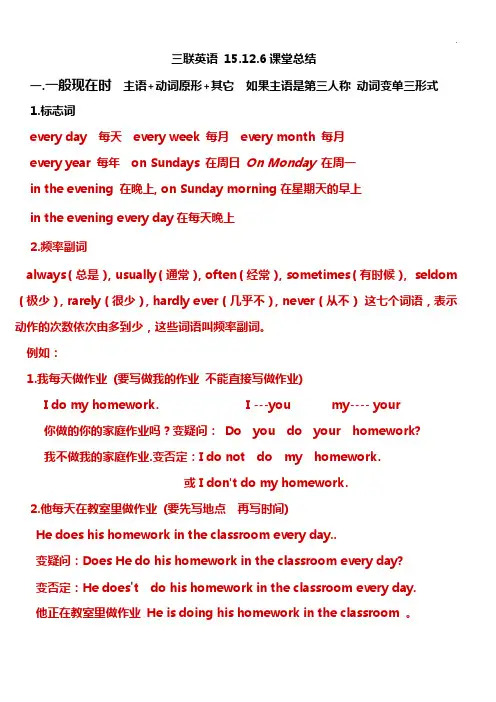
三联英语15.12.6课堂总结一.一般现在时主语+动词原形+其它如果主语是第三人称动词变单三形式1.标志词every day 每天every week 每月every month 每月every year 每年on Sundays 在周日On Monday在周一in the evening 在晚上, on Sunday morning在星期天的早上in the evening every day在每天晚上2.频率副词always(总是), usually(通常), often(经常), sometimes(有时候), seldom (极少),rarely(很少),hardly ever(几乎不),never(从不)这七个词语,表示动作的次数依次由多到少,这些词语叫频率副词。
例如:1.我每天做作业(要写做我的作业不能直接写做作业)I do my homework. I ---you my---- your你做的你的家庭作业吗?变疑问:Do you do your homework?我不做我的家庭作业.变否定:I do not do my homework.或 I don't do my homework.2.他每天在教室里做作业(要先写地点再写时间)He does his homework in the classroom every day..变疑问:Does He do his homework in the classroom every day?变否定:He does't do his homework in the classroom every day.他正在教室里做作业He is doing his homework in the classroom 。
3.我的妈妈和我周末去超市. 不是单三形式My mom and I go to ghe shops every weekend.变疑问:Do your mom and you go to ghe shops every weekend ? 变否定:My mom and I don't go to ghe shops every weekend.4.她每天看电视She watches TV every day变疑问:她每天看电视吗?Does she watch TV every day?变否定:She doesn't watch TV every day。
一般现在时与现在进行时的区别一般现在时和现在进行时是初一阶段所学的两种重要时态,它们的不同之处有以下几点:1基本用法不同;2谓语动词的形式不同;3时间状语不同;4有不同的特殊用法;一、基本用法不同一般现在时用来表示习惯性的动作或状态;如:She goes to school by bike every day.她每天骑自行车去上学;现在进行时用来表示现在说话的瞬间正在发生或进行的动作或者用来表示现阶段正在进行或存在的状态;如:Look She is reading under the tree.瞧她正在树下看书;二、谓语动词的形式不同一般现在时的谓语动词:1 be动词用am/is/are这三种形式;2实义动词用动词原形或第三人称单数形式根据主语数的变化而变化;现在进行时谓语动词的形式为:am / is / are+动词-ing 形式;如:We go to school at seven in the morning.我们早晨七点钟上学;I am reading English now. 我现在正在读英语;三、时间状语不同一般现在时常与often, sometimes, always, usually等频率副词连用,还与every morning /day / week..., on Wednesday, in the morning / afternoon / evening等时间状语连用;现在进行时常与now, these days, these weeks等时间状语连用;句首有Look / Listen 等提示语时,后面的句子中动词一般用现在进行时;四、特殊用法不同1. 一般现在时的特殊用法:表示客观真理、自然现象往往要用一般现在时表示;如:The moon goes round the earth.月亮绕着地球转;2. 现在进行时的特殊用法:现在进行时与always 连用时,往往含有赞扬、厌恶、责备等感情色彩;如:He is always working hard.他总是非常努力地工作;表示赞扬come, go, begin, start, leave 等动词常用现在进行时表示将要发生的动作;如:I'm coming. 我就来;一般现在时考点分析①表示客观事实或普通真理不受时态限制The geography teacher told us the earth moves around the sun.Water boils at 100oC.②表示现状、性质、状态时多用系动词或状态动词;表示经常或习惯性的动作,多用动作动词,且常与表频率的时间状语连用;Ice feels cold.We always care for each other and help each other.③表示知觉、态度、感情、某种抽象的关系或概念的词常用一般现在时:see、hear、smell、taste、feel、notice、agree、believe、like、hate、want、think、belong seem等;如:I know what you mean.Smith owns a car and a house.All the students here belong to Middle School.4少数用于表示起止的动词如come、go、leave、arrive、fly、return、start、begin、pen、close、end、stop等常用一般现在时代替将来时,表示一个按规定、计划或安排要发生的动作;当be表示根据时间或事先安排,肯定会出现的状态,只用一般现在时;The shop closes at 11:00 . every day.Tomorrow is Wednesday.现在进行时考点分析;①表示说话时正在发生着的一个动作;表示现阶段但不一定是发生在讲话时;表近期特定的安排或计划;go、come等起止动作可用进行时代替将来时;如:It is raining now.He is teaching English and learning Chinese.I am meeting Mr. Wang tonight.We are leaving on Friday.At six I am bathing the baby.I start bathing the bady before six.The girl is always talking loud in public.与always、often等频度副词连用,表经常反复的行动或某种感情色彩②下面四类动词不宜用现在进行时;A表示心理状态、情感的动作:like, love, hate, care, remember, believe, want, mind, wish, agree, mean, need;B表存在的状态的动词:appear, exist, lie, remain, seem belong to, depend on;C表示一时性动作的动词:allow, accept, permit, promise, admit, complete;D表示感官的动词:see, hear, notice, feel, smell, sound, taste, look;习题一.写出下列动词的第三人称单数形式;sit swim read make runwrite type go watch cleancry wash jump come study二.用do does填空does 用于第三人称单数,其余用do1、_____ you ride a bike after school Yes, I ________.2\______ your sister like PE No, she ______ not.3\ What_______ the students have They have some pens.4\ How______ Linda go to school She goes to school on foot.5\He ______ not speak English. He speaks Cjinese.6\ ______ they watch TV on Sundays Yes, they ______ .7\ My father and mother ______ not read newspapers on Saturday.三.用一般现在时填空;每句若有两个空要填一般第一个空填do 或does,第二个空填动词原形1、What ______ he _____ have He ________ have a toy plane.2、My mother ________ not________ like English. She _______ like Chinese.3、______ you ______ go to school by bus No, I _____ go to school by car.4、Miss Wang ______ swim every day.5、I _____like English . Tom ______ _______ _______not like English.6、The moon ______ go around the earth.7\When_____ you _______ go to school I _____ go to school at five every day.四.写出下列动词的现在分词;直接加ing去e加ing 双写加ingsit swim read make run watch sing do jump comewrite type go ski clean study stop say cry wash五.用进行时填空;1\ I ____ _____ read English now.2 \ He ______ _______ go to the park now.3\ We ________ ________ have an English class.4\ What ________ they ______ do They _______ ________ sit in the park.5\ My mother __________ ________ clean the room now.六、用动词的适当形式填空;1\ My mother _________wash the plates in the kitchen every day.2\ Please _________ have some oranges.3\ It’s seven o’clock. I _______ get up now.4\ School is over. The pupils can _______ play games.5\ ________ you ________ go to school every day6\ Don’t ________ run in the school now.7\ We ___________ like music. Now we _______ sing8\ Let me ____________ go to the cinema.9\ Mary, ________ you ________ clean the table now Yes.10\ My hands are dirty. Let me _________go and _______ wash them.11\ Look, Miss White ________have a maths lesson. We _______like maths.12\ The workers _________ want some tea. They are thirsty.13\ Listen, who _________ speak English in the park14\ The runners __________run every morning.15\ I can ________ listen to the radio on Sunday.七.填空1. We often___________play in the playground2.He _________get up at six o’clock.3. __________you _________brush your teeth every morning.4. What do he usually do after school5. Danny study English, Chinese, Maths, Science and Art an school.6. Mike sometimes __________go to the park with his sister.7. At eight at night, she __________watch TV with his parents.8. ________ Mike________read English every day9. How many lessons_________ your classmate________have on Monday10. What time_________ his mother_________do the housework八.改句子1. Do you often play football after school 肯定回答2. I have many books. 改为否定句3. Gao Shan’s sister likes playing table tennis 改为否定句4. She lives in a small town near New York. 改为一般疑问句5. I watch TV every day. 改为一般疑问句6. David has got a goal. 改为一般疑问句7. We have four lessons.否定句8. Nancy doesn’t run fast 肯定句9. My dog runs fast. 否定句:一般疑问句:10. Mike has two letters for him. 一般疑问句:否定句:11. I usually play football on Friday afternoon. 否定句: 一般疑问句: 划线提问12. Su Yang usually washes some clothes on Saturday. 否定句: 一般疑问句: 划线提问:13. Mingming usually waters the flowers every day 否定句: 一般疑问句: 划线提问14. To现在进行时专练一按要求改写句子1. The boy is playing basketball.否定句:____________________________一般疑问句:_________________________肯定回答:______________否定回答:____________对“is playing basketball”提问:__________________________对“ The boy”提问:__________________________2. They are singing in the classroom.否定句:____________________________一般疑问句:_________________________肯定回答:______________否定回答:________________对“are singing ”提问:__________________________对“ in the classroom”提问:__________________________3.仿照例句造句:Model: read, a book--What are you doing --I'm reading a book.1.read a new book________________2.clean the blackboard________________4. she, the window, open, now.用现在进行时连词成句._____________________5. The birds are singing in the tree.就划线部分提问_______________________6. is, who, the window, cleaning连词成句______________________7. The children are playing games near the house.就划线部分提问________________________8. She is closing the door now.改成否定句______________________9. You are doing your homework.用"I"作主语改写句子______________________, the tree, sing, now, under.用现在进行时连词成句._____________________11. The Young Pioneers are helping the old woman.改成一般疑问句II.单项选择1.我在照看孩子.AI am looking after the baby. BI'm look aftering the baby.CI look am aftering the baby. DI looking after the baby.'s making ______a kite.AI, me BMy, my CMy, me DHis, histhe woman ______ yellow your teacherAin Bputting on Cwearing DhavingThe twins _____their mother do the housework.Aare wanting Bhelp Care helping Dare looking翰林汇the birds doing They are singing in a tree.AWho BWhat CHow DWhereshe ____ somethingAeat Beating Ceatting Deats7.你在干什么AWhat is you doing BWhat are you doCWhat are you doing DWhat do you doare you listening_____A/ Bfor Cat Dto9.我正在听他说话.AI listening to him. BI'm listening to him.CI'm listen to him. DI'm listening him.are_____ their clothes.Amakeing Bputting Cput away Dputting on She____ in the classroom.Ais singing Bsing Cto sing Dis singJim______ his white shirt and brown trousers.Ais putting on Bwear Cput on Dis wearingyou eating I'm eating______ meat.AWhat, some BWhich, any CWhere, not DWhat, ain the evening. They do their homework.Aare watching Bcan't watchingCdon't watch Ddon't watching children_____ football.Ais playing Bare playing Cplay the Dplay aare flying kites.A他们喜欢放风筝. B他们在放风筝吗C他们在放风筝. D他们常放风筝.are many books. Please_____ them.Alook Bwrite Ccount Dtaking,They are swimming in the want_____ you.Ato go with Bgo with Chelping Dhelpman_____work near the house now.. Lucy is_____ a new bike today.Ajumping Brunning Criding Dtakeing III.用现在进行时完成下列句子:dosing an English song.mendmend a car.fly a kite Yes,_______.sit in the boatask questionsplay games now.。
时态、动词语法
时态是英语语法中非常重要的概念,它用来表示动作或状态发生的时间。
在小学阶段,学生通常需要掌握的基本英语时态有以下四种:
一般现在时(Simple Present Tense):用于描述习惯性动作、事实、真理或经常性的行为。
例句:I study English every day. (我每天学习英语。
)现在进行时(Present Continuous Tense):用于描述正在进行的动作或现阶段内持续的动作。
例句:We are playing football now. (我们现在正在踢足球。
)
一般过去时(Simple Past Tense):用于描述过去某个时间发生的动作或存在的状态。
例句:Yesterday, I went to the park. (昨天我去公园了。
)过去进行时(Past Continuous Tense):表示过去某段时间内一直在进行的动作。
例句:At that time, they were watching a movie. (那个时候,他们正在看电影。
)
动词根据不同的时态会有相应的变化形式,包括:
动词原形(Infinitive)
第三人称单数形式(如:play →plays)
过去式(如:play →played)
过去分词(如:play →played)
现在分词(如:play →playing)
除了这四大基础时态外,随着年级的升高,学生还会接触到更多的时态,例如将来时(Future Tense)、完成时态(Perfect Tenses)等。
对于小学生来说,理解并熟练运用这些基本时态对于建立良好的语言基础至关重要。
一般现在时和现在进行时的区别一、概念不同:一般现在时表示主语经常性和习惯性的动作或存在的状态,也表示说话者的能力及自然现象。
而现在进行时表示说话时(瞬间)正在进行的动作,也表示目前或现阶段一直进行的动作。
如:She often does her homework in the evening. 她经常在晚上做作业。
She is doing her homework now. 现在她正在做作业。
二、在构成方式上的不同:一般现在时中谓语动词的构成有以下三种情况:①be动词的一般现在时形式:am,is,are.②动词have的一般现在时形式:have,has.③其他行为动词的一般现在时形式有动词原形或第三人称单数形式。
而现在进行时中谓语动词的构成是:am/is/are+动词的-ing形式(现在分词)。
三、时间状语不同:一般现在时的时间状语主要有:always,usually,often,sometimes,never,every day/week/month/year,on Sundays,in the morning/afternoon/evening等;现在进行时的时间状语主要有:now,these days,this week,at the moment等,有时句首有“Look!”、“Listen!”或“It’s+时刻”等词、句存在。
如:We play football in the afternoon.我们在下午踢足球。
(一般现在时)My mother is reading a newspaper now. 我妈妈正在看报纸。
(现在进行时)一般现在时、现在进行时复习题一、写出下列动词的现在分词形式get ___________ sing__________ play__________ take__________ study_________dance_________ have__________ write__________ run___________ sit___________ shop__________ swim__________二、写出下列动词的第三人称单数形式work__________ read__________ clean__________ write__________ teach__________ wash__________ guess__________ watch__________ go____________ do___________ photo__________ study__________fly__________ cry__________ play_________ have__________三、用动词的适当形式填空1. She ______________ (go) to school at eight o’clock.2. It’s six o’clock. They _____________ (eat)supper.3. He usually ___________(get ) up at 17:00.4. She ___________ (live) in Beijing.5、I (want) to do homework now.6、My father always __________(come) back from work very late.7、The teacher is busy. He __________ (sleep) six hours a day.8、Listen! Jane __________(sing) in the classroom. She often _________ (sing) there.9、__________ your brother __________(know) Japanese?10、Where __________ you __________ (have) lunch every day?11、The girl _____(like) wearing a skirt. Look! She ______ __(wear) a red skirt today.12、It's time______ (go) to school13、______you______(clean)the blackboard now?14、Let's ______(go)and help her.15、What are they doing? They ___________(put)things away.16、He often _________ (have)supper at 6:00 in the evening.(get)up.17、It’s 6 o’clock in the morning. He ___________.18、Tom _________ (have) an English class now.13. Listen! The girl _____________(sing)in the room.14. I ___________(read)a book in the room at the moment.16. Where _________ he _________ (come)from?17. Who ________(sing)over there now?18、Listen! The baby ________(cry)in the next room.19、Look! The twins (wear)new sweaters.20、Don’t talk here. Grandparents __________ _ (sleep).21、Mrs Read _________(clean)the windows every day.22.、On Sunday he sometimes _______(wash)his clothes and sometimes ________(do)someshopping.23、The twins usually ____ (have)milk and bread for breakfast, but Jim _____ (have)somecoffee for it.24、---What ______ you ______ (do)? ---I _______ (make) cakes.25、Sometimes she ________ (watch) TV.26、Now she _________ (watch) TV. Jim, my good friend, ______ (be) sixteen years old.27、There ______ (be) some books and pens on the desk.28、Mrs White ______ (teach) English. She ________ (teach) English now.29、---______ you ______ (make) a model plane? ---Yes, I am.30、---How ______ you ______ (like) China? ---I ______ (like) China very much。
一般现在时定义:一般现在时表示现在经常反复发生的动作、存在的状态或习惯性的动作的时态。
构成:一般现在时用行为动词的原形,但第三人称单数作主语时,动词的词尾要加-S。
(1.一般的动词词尾+S。
2.以sh/ch/s/x结尾的词+es. 3.以辅音字母Y 结尾的把Y变成i,+es。
4.辅音字母+o结尾的+es.)形式:主语+动词原形+宾语用法:1.表示经常的或习惯性的动作,常与表示频度的时间状语连用。
2.表示主语具备的性格、能力和特征。
3.表示现在的状态。
4.表示客观事实和普遍真理。
5.在时间状语从句和条件状语从句中,常用一般现在时代替将来时。
6.表示预先计划或安排好的行为。
7.小说故事用一般现在时代替一般过去时。
8.有些表示状态和感觉的动词表示现在发生的具体行为时,只用一般现在时,而不用进行时态。
9.表示现在发生的具体动作或存在的状态一般现在时的用法:1)经常性或习惯性的动作,常与表示频度的时间状语连用。
时间状语:always, usually,,every morning/night/evening/day/week,often,sometimes,never.例如:I leave home for school at 7 every morning. 2) 客观真理,客观存在,科学事实。
The earth moves around the sun. Shanghai lies in the east of China.3)表示格言或警句中。
Pride goes before a fall. 骄者必败。
☆注意★:此用法如果出现在宾语从句中,即使主句是过去时,从句谓语也要用一般现在时。
例:Columbus proved that the earth is round.. 4) 现在时刻的状态、能力、性格、个性。
I don't want so much. Ann Wang writes good English but does not speak well. 5).表示按规定、计划或时间表将要发生的事。
He starts next week. 他下个星期出发。
The train starts at 10 o'clock in the morning. 火车将在早上10点开出。
这类用法限于表示“移动”的动词:go去,come来,leave离开,start出发,begin开始,arrive到达,take off起飞,等。
一般现在时Be动词情况am,is,are也可以做一般现在时的助动词例如:I am a student. 一般现在时表将来:下列动词:come, go, arrive, leave, start, begin, return,live,fly的一般现在时表将来。
这主要用来表示在时间上已确定或安排好的事情。
The train leaves at six tomorrow morning. When does the bus start? It starts in ten minutes.动词的单三形式讲解大家都知道,在一般现在时中,当主语是第三人称单数时,谓语动词要用第三人称单数形式,即常在动词原形后加-s或-es。
但有些同学们对于哪些主语是第三人称单数还不十分清楚,现归纳总结如下:一、人称代词he, she, it是第三人称单数。
如:He likes watching TV. 他喜欢看电视。
She has lunch at twelve. 她十二点吃午餐。
It looks like a cat. 它看起来像只猫。
二、单个人名、地名或称呼作主语;是第三人称单数。
如:① Han Mei looks like her mother. 韩梅看起来像她的母亲。
② Beijing is in China. 北京在中国。
③ Uncle Wang often makes cakes. 王叔叔经常做蛋糕。
三、单数可数名词或"this / that / the+单数可数名词"作主语时,是第三人称单数。
如:① A horse is a useful animal. 马是有用的动物。
② This book is yours. 这本书是你的。
③ That car is red. 那辆小汽车是红色的。
④ The cat is Lucy's. 这只猫是露茜的。
四、不定代词someone, somebody, nobody, everything, something等及指示代词this, that作主语时,是第三人称单数。
如:① Everyone is here. 大家到齐了。
② There is something wrong with the watch. 这块手表有毛病。
③ This is a pen. 这是一支钢笔。
④ That is an eraser. 那是一块橡皮擦。
五、不可数名词作主语时为第三人称单数。
如:① The milk is in the glass. 牛奶在玻璃杯里。
② The bread is very small. 那面包很小。
六、当数字或字母作主语时,看作第三人称单数。
如:①"6" is a lucky number. "6"是个吉利数字。
②"I" is a letter. "I"是个字母。
第三人称单数形式的构成1.一般直接在词尾加s,如:work-works live-lives make-makes2.以s,x,ch ,sh等结尾的单词加es , 如:fix-fixes watch-watchesfinish-finishes teach-teaches3.以辅音字母加y结尾的单词,变y为i加es , 如:fly-flies4.以辅音字母加o结尾的单词,加es 如: go-goes do-does动词单三的练习一. 根据括号里单词的适当形式填空1. She _____ (be ) a writer.2. It _____(look) like a monkey.3. We_____(go) to the park.4. He _____(go) to school.5. Amy_____(like) eating fruits.6. Hebei_____(be) next to Shandong.7. Our teacher _____(be) talking with John.8. Whose book _____(be) this ?9. Dogs _____(be) our friends .10. That blackboard _____(be) clean.11. The desk _____(be) Tom’s.12. Somebody _____(do) her homework .13. Everybody _____(is ) ok!14. Nobody _____ (be) in the park .15. There _____(be)someone in the classroom .16. That cat _____(be ) mine .17. A little water _____(be) in the cup.18. Cheese _____(taste)well .19. The letter “O” _____(look) like zero.20. “4” _____(be) a bad number in China .二. 把下列句子改成第三人称单数句的肯定句、否定句、一般疑问句,并做回答。
1. I like playing the pinao in the music room . (Tom)2. You need a pencil-box for new term . (Sam’s sister)3.I do my homework at half past four in the afternoon . (she)4. I have breakfast at twenty-five past seven in the morning . (her father )5. I watch TV at quarter past six with my parents . (Tom’s sister)现在进行时1.现在进行时表示现在正在进行或发生的动作。
2.a.现在进行时的肯定句基本结构:主语+be+ 动词ing. 如:I am eating.b.现在进行时的否定句基本结构:主语+be not + 动词ing. 如:I am not eating.c.现在进行时的一般疑问句基本结构:be动词+主语+动词ing. 如Are you eating?d.现在进行时的特殊疑问句基本结构:特殊疑问词+ be +主语+动词ing?如:What are you eating?动词的ing形式(动词的现在分词)的变化规则1 一般情况下直接在动词后面加ingread—reading sleep---sleeping study---studying clean--cleaning play---playing2 以不发音的字母e结尾的动词,去掉字母e,再加ingcome---coming make---making ride---riding have---having take---taking write---writing dance---dancing3 以重读闭音节(重读闭音节即两个辅音中间夹一个元音并且重读的音节)结尾,呈现“辅,元,辅”结构的动词,双写末尾的辅音字母,再加ingstop--stopping停sit--sitting run--running跑begin—beginning开始cut--cutting切get--getting得到swim--swimming游dig--digging挖5、现在进行时用法口诀主语在句首,am, is, are跟在后,现在分词跟着走,其他成分不可丢。
表示动作正进行,句中now时间定。
一般问句,把be提到句前去。
否定句式也简单,be后只把not添。